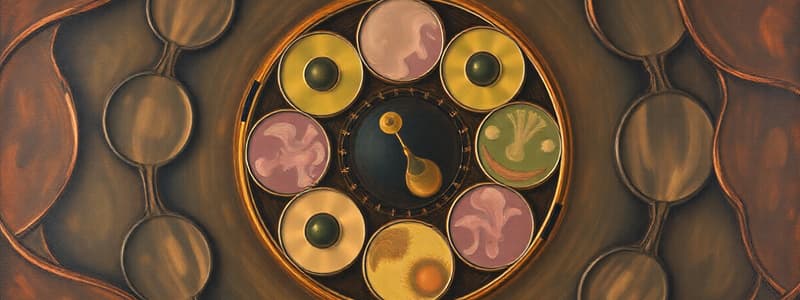Podcast
Questions and Answers
What happens to M-Cdk activity at the end of mitosis?
What happens to M-Cdk activity at the end of mitosis?
- It is increased by cyclin degradation.
- It is activated by spindle assembly.
- It is inactivated by M-cyclin degradation. (correct)
- It remains constant due to positive feedback.
What role does the APC/C protein complex play in the cell cycle?
What role does the APC/C protein complex play in the cell cycle?
- It attaches ubiquitin to cyclin proteins. (correct)
- It activates cyclins for cell cycle progression.
- It inhibits the proteasome activity.
- It synthesizes new M-cyclin proteins.
What is the purpose of poly-ubiquitylation of proteins in cells?
What is the purpose of poly-ubiquitylation of proteins in cells?
- It signals proteins for destruction by the proteasome. (correct)
- It marks proteins for promotion of activity.
- It stabilizes proteins for longer activity.
- It enhances protein folding and function.
What directly contributes to the loss of M-Cdk activity at the spindle-assembly checkpoint?
What directly contributes to the loss of M-Cdk activity at the spindle-assembly checkpoint?
During the G2 phase of the cell cycle, what generally happens to the size of cells?
During the G2 phase of the cell cycle, what generally happens to the size of cells?
What is the significance of checkpoints in the cell cycle?
What is the significance of checkpoints in the cell cycle?
Which phase do cells enter if they stop dividing temporarily?
Which phase do cells enter if they stop dividing temporarily?
What would be the consequence of a cell dividing before its DNA has fully replicated?
What would be the consequence of a cell dividing before its DNA has fully replicated?
Which proteins are primarily responsible for regulating the cell cycle?
Which proteins are primarily responsible for regulating the cell cycle?
How do cells ensure that all constituents are doubled before division?
How do cells ensure that all constituents are doubled before division?
What characterizes post-mitotic cells?
What characterizes post-mitotic cells?
Which cell phase involves preparing for DNA synthesis?
Which cell phase involves preparing for DNA synthesis?
What triggers the progression of cells through the G1/S checkpoint?
What triggers the progression of cells through the G1/S checkpoint?
What happens if a cell duplicates its DNA but fails to double its organelles before division?
What happens if a cell duplicates its DNA but fails to double its organelles before division?
Which regulatory mechanism is associated with the G2/M checkpoint?
Which regulatory mechanism is associated with the G2/M checkpoint?
What happens when a checkpoint is 'activated' in the cell cycle?
What happens when a checkpoint is 'activated' in the cell cycle?
Which protein plays a significant role as a regulator at the G1/S checkpoint?
Which protein plays a significant role as a regulator at the G1/S checkpoint?
What state do cells enter when they temporarily leave the cell cycle?
What state do cells enter when they temporarily leave the cell cycle?
Which checkpoint is associated with the removal of Cdk inhibitor proteins?
Which checkpoint is associated with the removal of Cdk inhibitor proteins?
What is the consequence of p53 mutation in relation to the cell cycle?
What is the consequence of p53 mutation in relation to the cell cycle?
Which checkpoint is responsible for ensuring that all chromosomes are properly aligned before proceeding?
Which checkpoint is responsible for ensuring that all chromosomes are properly aligned before proceeding?
What is the primary role of the Wee1 kinase in the cell cycle?
What is the primary role of the Wee1 kinase in the cell cycle?
What consequence follows the loss of p53 function in a cell?
What consequence follows the loss of p53 function in a cell?
Which statement accurately describes the role of Cdc25 phosphatase in the cell cycle?
Which statement accurately describes the role of Cdc25 phosphatase in the cell cycle?
What is the primary function of cyclin-dependent kinases (Cdks) in the cell cycle?
What is the primary function of cyclin-dependent kinases (Cdks) in the cell cycle?
What would likely happen to the cell cycle if Wee1 kinase were deleted?
What would likely happen to the cell cycle if Wee1 kinase were deleted?
How do cyclin proteins affect the activity of Cdks?
How do cyclin proteins affect the activity of Cdks?
What happens at checkpoint mechanisms in the cell cycle?
What happens at checkpoint mechanisms in the cell cycle?
During which phase of the cell cycle does M-cyclin accumulate?
During which phase of the cell cycle does M-cyclin accumulate?
What initiates the abrupt triggering of M-Cdk activity?
What initiates the abrupt triggering of M-Cdk activity?
Which cyclin is primarily associated with the M-phase of the cell cycle?
Which cyclin is primarily associated with the M-phase of the cell cycle?
What is one role of the S-cyclin in the cell cycle?
What is one role of the S-cyclin in the cell cycle?
What process does active M-Cdk catalyze concerning Wee1?
What process does active M-Cdk catalyze concerning Wee1?
What phenomenon describes the relationship between Cdc25 and M-Cdk during the G2/M checkpoint?
What phenomenon describes the relationship between Cdc25 and M-Cdk during the G2/M checkpoint?
Which of the following best describes a checkpoint in the context of the cell cycle?
Which of the following best describes a checkpoint in the context of the cell cycle?
Which checkpoint is responsible for ensuring that the DNA is not damaged before the cell cycle proceeds?
Which checkpoint is responsible for ensuring that the DNA is not damaged before the cell cycle proceeds?
What is required for the cyclin-dependent kinases (Cdks) to become active?
What is required for the cyclin-dependent kinases (Cdks) to become active?
Flashcards
Spindle-assembly checkpoint
Spindle-assembly checkpoint
A checkpoint ensuring all chromosomes are correctly attached to the spindle microtubules before sister chromatids separate during mitosis.
M-Cdk inactivation
M-Cdk inactivation
M-Cdk is a protein complex that drives entry into mitosis. Its activity is regulated by the degradation of M-cyclin, a key component of the complex.
Anaphase-promoting complex (APC/C)
Anaphase-promoting complex (APC/C)
A large protein complex responsible for attaching ubiquitin chains to proteins. This marks the protein for destruction by the proteasome.
Proteasome
Proteasome
Signup and view all the flashcards
Ubiquitin
Ubiquitin
Signup and view all the flashcards
Cyclin-dependent kinases (Cdks)
Cyclin-dependent kinases (Cdks)
Signup and view all the flashcards
Cyclins
Cyclins
Signup and view all the flashcards
Cell cycle
Cell cycle
Signup and view all the flashcards
Checkpoints
Checkpoints
Signup and view all the flashcards
G2/M checkpoint
G2/M checkpoint
Signup and view all the flashcards
G1/S checkpoint
G1/S checkpoint
Signup and view all the flashcards
DNA replication
DNA replication
Signup and view all the flashcards
What are the four phases of the cell cycle?
What are the four phases of the cell cycle?
Signup and view all the flashcards
What happens during the G1 phase?
What happens during the G1 phase?
Signup and view all the flashcards
What happens during the S phase?
What happens during the S phase?
Signup and view all the flashcards
What happens during the G2 phase?
What happens during the G2 phase?
Signup and view all the flashcards
What happens during the M phase?
What happens during the M phase?
Signup and view all the flashcards
What are post-mitotic cells?
What are post-mitotic cells?
Signup and view all the flashcards
What is G0 phase?
What is G0 phase?
Signup and view all the flashcards
Why is it important for the cell cycle to be precisely controlled?
Why is it important for the cell cycle to be precisely controlled?
Signup and view all the flashcards
G1/S checkpoint (aka G1 checkpoint)
G1/S checkpoint (aka G1 checkpoint)
Signup and view all the flashcards
Cdk Inhibitor Protein
Cdk Inhibitor Protein
Signup and view all the flashcards
G0 state
G0 state
Signup and view all the flashcards
DNA damage and the G1/S checkpoint
DNA damage and the G1/S checkpoint
Signup and view all the flashcards
P53
P53
Signup and view all the flashcards
P27
P27
Signup and view all the flashcards
Wee1 Kinase
Wee1 Kinase
Signup and view all the flashcards
Cdc25 Phosphatase
Cdc25 Phosphatase
Signup and view all the flashcards
Positive Feedback Loop in G2/M Checkpoint
Positive Feedback Loop in G2/M Checkpoint
Signup and view all the flashcards
Loss of p53 Function
Loss of p53 Function
Signup and view all the flashcards
Normal Cell to Cancer Cell Conversion
Normal Cell to Cancer Cell Conversion
Signup and view all the flashcards
Study Notes
Cell Division Cycle Overview
- The cell cycle is crucial for ordered cell division, and defects can have serious consequences.
- The cycle involves four stages, with specific events occurring in each.
- Cyclins and cell cycle kinases control the progression through the cycle.
- Checkpoints in the cycle ensure that one step is properly completed before the next begins.
Today's Topics
- Overview of the cell cycle's four stages.
- Cyclin-dependent kinases (Cdks) and their function.
- The mechanisms of checkpoints.
The Cell Division Cycle Stages
- Cell Growth and Chromosome Replication: The cell grows and duplicates its chromosomes.
- Chromosome Segregation and Organelle Segregation: Chromosomes and organelles are segregated. This is the stage where the cell divides the replicated chromosomes and other material.
- Cell Division: The cell physically divides into two daughter cells.
Cell Cycle Phases
- Interphase: The period between cell divisions. Sub-divided into G1, S, and G2 phases.
- G1 Phase: Growth and preparation for DNA replication (S phase).
- S Phase: DNA replication.
- G2 Phase: Growth and preparation for mitosis.
- M Phase: Mitosis (nuclear division) and cytokinesis (cytoplasmic division).
Cell Cycle Duration
- Duration varies greatly between different cell types.
- Examples include early fly and frog embryos (minutes), mammalian intestinal cells (hours), and mammalian fibroblasts (hours to days).
Challenges of Cell Division
- Cells must precisely duplicate their contents and divide them equally between two daughter cells.
- Errors in these processes can be catastrophic.
Cyclin-dependent Kinases (Cdks)
- The activity of Cdks changes throughout the cell cycle.
- Cdks require cyclins for their activity.
- Variations in cyclin concentration throughout the cycle control Cdk activity and trigger specific events.
Checkpoints
- Checkpoints ensure that one phase is completed before the next begins.
- These are critical to cell cycle regulation
- Essential for maintaining the integrity of the genome and preventing the creation of damaged cells.
G1/S Checkpoint
- Cells decide whether to enter the cell cycle based on environmental signals.
- Growth factors like epidermal growth factor (EGF) signal the cells to proceed.
- Cells can temporarily leave the cycle at G0 and stop dividing.
G2/M Checkpoint
- Checks if DNA is replicated correctly.
- Checks for any DNA damage that needs repair before mitosis.
Spindle-Assembly Checkpoint
- Ensures all chromosomes are properly attached to the mitotic spindle(s) before anaphase.
- This assures equal division of chromosomes between daughter cells.
Mechanisms for Regulating Cdk Activity
- Cdk inhibitor proteins
- Phosphorylation
- Protein degradation
M-Cdk Inactivation
- M-cyclin degradation triggers M-Cdk inactivation.
- APC/C is a protein complex responsible for this degradation.
Wee1 Kinase and Cdc25 Phosphatase
- Wee1 kinase inhibits M-Cdk activity.
- Cdc25 phosphatase activates M-Cdk activity.
Studying That Suits You
Use AI to generate personalized quizzes and flashcards to suit your learning preferences.




